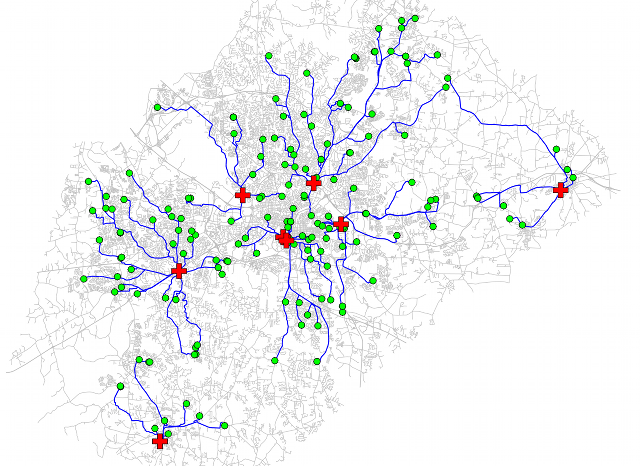DESCRIPTION
v.net.distance finds the nearest element in set to
for every point in set from.
NOTES
These two sets are given by the respective layer, where
and cats parameters. The type of to features is
specified by to_type parameter. All from features
are points. A table is linked to output map
containing various information about the relation. More
specifically, the table has three columns: cat, tcat
and dist storing category of each from
feature, category of the nearest to feature and the
distance between them respectively. Furthemore, output map
contains the shorest path between each cat, tcat
pair. Each path consist of several lines. If a line is on the
shorest path from a point then the category of this point is
assigned to the line. Note that every line may contain more than one
category value since a single line may be on the shortest path for
more than one from feature. And so the shortest paths can
be easily obtained by querying lines with corresponding category
number.
The costs of arcs in forward and backward direction are specified by
afcolumn and abcolumn columns respectively. If
abcolumn is not given, the same cost is used in both directions.
v.net.distance will not work if you are trying to find the
nearest neighbors within a group of nodes, i.e. where to
and from are the same set of nodes, as the closest node
will be the node itself and the result will be zero-length paths. In
order to find nearest neighbors within a group of nodes, you can
either loop through each node as to and all other nodes as
from or create a complete distance matrix with
v.net.allpairs and select the
lowest non-zero distance for each node.
EXAMPLES
Find shortest path and distance from every school to the nearest hospital
and show all paths.
Streets are grey lines, schools are green circles, hospitals are red
crosses, shortest paths are blue lines:

# connect schools to streets as layer 2
v.net input=streets_wake points=schools_wake output=streets_net1 operation=connect thresh=400 alayer=1 nlayer=2
# connect hospitals to streets as layer 3
v.net input=streets_net1 points=hospitals output=streets_net2 operation=connect thresh=400 alayer=1 nlayer=3
# inspect the result
v.category in=streets_net2 op=report
# shortest paths from schools (points in layer 2) to nearest hospitals (points in layer 3)
v.net.distance in=streets_net2 out=schools_to_hospitals flayer=2 tlayer=3
SEE ALSO
v.net.path,
v.net.allpairs,
v.net.distance,
v.net.alloc
AUTHORS
Daniel Bundala, Google Summer of Code 2009, Student
Wolf Bergenheim, Mentor
Markus Metz
Last changed: $Date$

